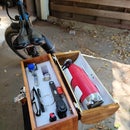Introduction: Build a Workshop Cabinet
I had 2 crappy cabinets and one crappy stand that held my planer, metal cutting bandsaw and sander. I wanted to combine all 3 into one stand. I'm planning on building many cabinets for my kitchen remodel, this seemed like a good time to test out some cabinet software that I recently purchased.
Since the cabinet resides in my workshop I saw no need to use expensive plywood. I found 3/4 OSB at Home Depot for around $16.00 per sheet. It was T&G so I adjusted the nesting accordingly.
Step 1: Tools and Materials Required
5 sheets of 3/4 OSB (4 to use and one to mess up).
3 pair of 24" full extension drawer slides.
1.5" staples and pneumatic staple gun .
4 tubes of construction adhesive and caulking gun.
4' x 8' or larger CNC router ( I built mine from a kit ).
1/4" spiral downcut router bit.
Screw gun.
Software Cabinet Parts Pro.
Omar nailer and plastic nails.
Dead blow hammer (or mallet).
Step 2: Design the Cabinet
First set your drawer settings to single drawer under 50 inches.
With Cabinet Parts Pro you choose your cabinet style and plug in the dimensions and hit "create cabinet parts and nest" then in the nesting window under tool paths set your templates :
Drawer holes: drill
Back dado: pocket
Back side dado: outside
Cut: outside
Plug in your bit size; I'm using a 1/4" spiral downcut for everything.
Set your pass depth. I used .4 so it would cut in 2 passes. This would give me time to follow along and put 2 plastic nails in each piece to hold the work down.
Set your cut speed, I used 120 inches per minute.
Default setting for material thickness is 3/4" and even though the OSB is slightly less than that everything worked out fine.
Click "save toolpaths to file choose your post processor, in this case I'm using Mach3 and out comes a gcode file for each sheet of plywood.
Step 3: Load They Plywood Onto the Machine and Start Cutting
Load the file into Mach3
I placed the plywood on the table and nailed the edges down with my Omar nailer and composite plastic nails. Then I started cutting following along and putting 2 or more plastic nails in each piece. Except the piece I forgot to nail which came loose and broke a router bit. I always try to have extra bits and inserts on hand for every project.
After the cut is complete just give the pieces a sideways whack with a dead blow hammer. then you can remove them from the table.
Step 4: Assemble the Cabinet and Drawers
I used construction adhesive, because of the uneven nature of OSB plywood, and 1 1/4" staples to put everything together. All the cuts were nice and square. I did not use the pre drilled holes with the drawer slides; I elected to do it the old fashioned way of measuring and scabbing on a straight piece of lumber to hold them as I put them in. I used KV slides as they have a neat feature that allows for some expansion and contraction of the material. I added another layer of OSB to the top for a total thickness of 1 1/2" to give a little extra strength.
The clamps were removed during assembly after everything was stapled together.
Step 5: Place and Bolt the Machinery to the Top
Ok I bolted and unbolted and moved things around couple of time before I had everything in place with proper clearance. All in all, I'm happy with the way it turned out. Thanks for looking.

Participated in the
Shelving Contest













